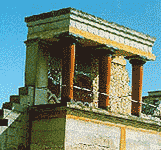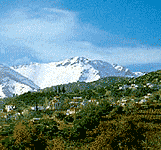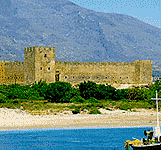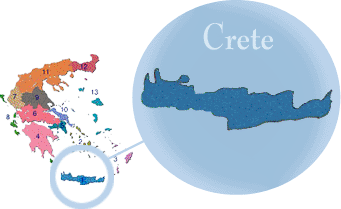Crete the land of Daidalos and Ikaros. Of Minoan vases and famous frescoes.Shining and starlit, with its  black baggy breeches and fringed kerchiefs. Romantic Crete with its sea, rocks and gleaming plateaus. Crete land of full-bodied wine and pungent tsipouro. Sleepless Crete land of endless feasts under star-student skies. Crete scented with wild fennel and fresh basil. Dizzying Crete of the warlike dances. Crete, home of El Greco, Kornaros, Kazantzakis and Prevelakis. Crete whose door is always wide open to both East and West. The dream of Crete, where a person might soar in flight. Crete, ‘’the island of Miracles’’.
black baggy breeches and fringed kerchiefs. Romantic Crete with its sea, rocks and gleaming plateaus. Crete land of full-bodied wine and pungent tsipouro. Sleepless Crete land of endless feasts under star-student skies. Crete scented with wild fennel and fresh basil. Dizzying Crete of the warlike dances. Crete, home of El Greco, Kornaros, Kazantzakis and Prevelakis. Crete whose door is always wide open to both East and West. The dream of Crete, where a person might soar in flight. Crete, ‘’the island of Miracles’’.
This island - the largest in Greece - separates the Aegean From the Libyan Sea, marks the boundary between Europe and Africa.Majestic mountains rise in its center - the White Mountains, Psiloritis Dikti. Its plateus are split by deep gorges and end up in fertile valleys. The scenery is constantly changing. In one place harsh and barren in another wooded and gentle. Its villages smothered in greenery. Olive trees orange groves, vineyards early vegetable market gardens. Old stone farmhouses, monasteries and villages perched on mountain ridges castels and and chapels forgotten on steep slopes. Shores lined with forbidding rocks, often inaccessible, but also lots of endless sandy or pebbly beaches. Crete is renowned for the variety of its vegetation and wildlife in its chestnut, oak and cypress forests. Not to mention its palm forests (at Vai and Preveli) and its cedar forests (at Gavdos and Hrissi). Medicinal herbs and fragment shrubs - laudanum, dittany marjoran and thyme - grow in rocky areas and the mountain tops are home of the ‘’Kri-Kri’’ or Cretan goat.
 Sitia - all grew up on the north side, which is more benign topographically. Ierapetra is the only port on the south coast, on the shores of the Libyan Sea, facing Africa. This island’s fertile soil and towering peaks witnessed the development of one of most important civilizations on Earth, the Minoan (2800-1150 BC.).
Sitia - all grew up on the north side, which is more benign topographically. Ierapetra is the only port on the south coast, on the shores of the Libyan Sea, facing Africa. This island’s fertile soil and towering peaks witnessed the development of one of most important civilizations on Earth, the Minoan (2800-1150 BC.). In succesive phace the Minoans built palace-states - the famous palatial centres of Knossos, Phaistos, Malia, Zakros (1700-1450 BC). Their painters and ceramists show us the limits the refinement of art reach. Their frescoes bring us close to the soul of that word , peace-loving, light-hearted, but also powerful. They bring us close to the sea and its wealth. A geological catastrophe - the eruption of the volcano of Santorini in 1450 BC - halted the Minoan civilization at its height. But life did not cease. Through shipping commerce and trade with other peoples - the Phoenicians, Syrians, Egyptian - opened up new horizons. With the invasion of the Achaians and the Dorians on the island the new cities of Lato and Aptera were founded. Lato became the most important city on Crete (7th century BC). Until the Roman occupation (69-330 AD). The most distinguished center in those days was Gortyn. But Christianity came to the island early. During the Byzantine era the wealth of Crete was shown off in the mosaic floors of its basilicals and in half the churches of Greece. But many others had their eye on these riches. First Crete fell into the hands of the Arabs (824) for one and half centuries (961). Handak, present-day Iraklio was founded. Then in 1204, the island passed to the Venetians.
 They fortified the old castles at Handak and built mew ones at Gramnoussa, Spinaloga, Fragokastello, Ierapetra, Palaiochora. They broke the ground for new cities (Chania and Rethimno) and built the fortifications essential to their defense. Inside the walls the cities developed with narrow, convoluted alleyways and small residential blocks, interspersed with decorate piazzas, fountains, churches and palaces, remains of which can still be seen today. Although the island was shaken from time to time by the rebellious populace, it continued to develop both economically and culturally. Painting and literature flourished. Domenicos Theotokopoulos (El Greco), Damaskinos and other iconographers paint exquisite portraits of the Virgin and Christ. Under the vaulted gates and arched windows troubadours passed singing ballads by Hortantzis about the suffering of Erotokritos and Erophili. In 1645 the Muslim conquerors set foot on the island for the first time. In 1669 the whole of Crete fell to the Turks. Not until 1913 was the island united with the rest of Greece. This island with its clear, warm sea boundless beaches lined with tamarisks, splendid plateaus and mild starry nights has more to offer than its past, its gorges, unscaled peaks and climate. Today it continues to live fully and to develop, its cities particularly changing in appearance from one day to next, in contrast to the many unchanging villages where life goes on in the same rhythm it has for centuries.
They fortified the old castles at Handak and built mew ones at Gramnoussa, Spinaloga, Fragokastello, Ierapetra, Palaiochora. They broke the ground for new cities (Chania and Rethimno) and built the fortifications essential to their defense. Inside the walls the cities developed with narrow, convoluted alleyways and small residential blocks, interspersed with decorate piazzas, fountains, churches and palaces, remains of which can still be seen today. Although the island was shaken from time to time by the rebellious populace, it continued to develop both economically and culturally. Painting and literature flourished. Domenicos Theotokopoulos (El Greco), Damaskinos and other iconographers paint exquisite portraits of the Virgin and Christ. Under the vaulted gates and arched windows troubadours passed singing ballads by Hortantzis about the suffering of Erotokritos and Erophili. In 1645 the Muslim conquerors set foot on the island for the first time. In 1669 the whole of Crete fell to the Turks. Not until 1913 was the island united with the rest of Greece. This island with its clear, warm sea boundless beaches lined with tamarisks, splendid plateaus and mild starry nights has more to offer than its past, its gorges, unscaled peaks and climate. Today it continues to live fully and to develop, its cities particularly changing in appearance from one day to next, in contrast to the many unchanging villages where life goes on in the same rhythm it has for centuries.
There are hundreds of cafes where one sit in the shade of a spreading plane, oak or mulb erry tree and sip a ‘’sweat’’ or ‘’medium’’ coffee, or a glass of ‘’tsikoudia‘’ (raki) while playing a game of cards or ‘’tavli’’ (backgammon). There are dozens of tavernas and ouzeries serving some tasty ‘’meze’’, a specialty of the area. Yogurt and honey, sweet tarts (kaltzounia), pies made of wild greens flavored with fennel, fried cheese (staka), rabbit stew, cheese pie from Hora Sfakion, cockles, boiled goat. In the city of Chania, at Malaxa, at Vrisses, and other villages in the area of Rethimno, in Iraklio and its villages and in the whole district of Lassithi. Fish, sea urchins, octopus and cuttlefish cooked on coal and fried squid to be tasted at seaside tavernas. And everywhere the delectable Cretan wine. Every saint’s feastday is celebrated with gusto at dozens of villages throughout the island; all Crete throbbing to the sound of the Cretan lyre and the rhythm of the local dances, the pentozali and the sousta. Meanwhile the housewives are preparing a steamed Cretan pilaf and special holiday fritters (xerotigana). In the shop windows of bustling Iraklio, picturesque Rethimno, and Chania, elegant furs, precious jewelry and artist silverware attract the visitor’s attention. In the shops of lovely Sitia and tranquil Ierapetra and in mountainous Anogia one is impressed by the spread out ‘’patanies’’, traditional local woven fabrics in dazzling colors, and everywhere one sees skillfully crafted ceramics and leather goods.
erry tree and sip a ‘’sweat’’ or ‘’medium’’ coffee, or a glass of ‘’tsikoudia‘’ (raki) while playing a game of cards or ‘’tavli’’ (backgammon). There are dozens of tavernas and ouzeries serving some tasty ‘’meze’’, a specialty of the area. Yogurt and honey, sweet tarts (kaltzounia), pies made of wild greens flavored with fennel, fried cheese (staka), rabbit stew, cheese pie from Hora Sfakion, cockles, boiled goat. In the city of Chania, at Malaxa, at Vrisses, and other villages in the area of Rethimno, in Iraklio and its villages and in the whole district of Lassithi. Fish, sea urchins, octopus and cuttlefish cooked on coal and fried squid to be tasted at seaside tavernas. And everywhere the delectable Cretan wine. Every saint’s feastday is celebrated with gusto at dozens of villages throughout the island; all Crete throbbing to the sound of the Cretan lyre and the rhythm of the local dances, the pentozali and the sousta. Meanwhile the housewives are preparing a steamed Cretan pilaf and special holiday fritters (xerotigana). In the shop windows of bustling Iraklio, picturesque Rethimno, and Chania, elegant furs, precious jewelry and artist silverware attract the visitor’s attention. In the shops of lovely Sitia and tranquil Ierapetra and in mountainous Anogia one is impressed by the spread out ‘’patanies’’, traditional local woven fabrics in dazzling colors, and everywhere one sees skillfully crafted ceramics and leather goods.
 In the ‘’Stivanadika’’ district of Chania (Skridolf. St) traditional boots (stivania) are still made in the old-fashioned way, because though it may seen strange even today there are Cretans who still wear their traditional costume. In the marketplace of same city, the one of its kind, but also in similar shops all over the island , every kind of food, fruit and vegetable produced in the fertile valleys, hot houses and mountain regions, is laid out on display. Exotic avocados, Belgian endive and bananas, juicy oranges and fragment melons, succulent figs and tasty prickly pears, delicious grapes, sweet tomatoes, tender cucumbers, fresh-picked greens from the hillsides, snails, mouth-watering sardines, tempting lobster, kid from the islet of Gavdos, honey perfumed with thyme and wonderful cheeses - graviera (gruyere), myzithra (ricotta), fresh white cheese, and soft luscious staka. The evenings are enchanting spent next to the intoxicating aroma of a jasmine vine in an open-air cinema, seated in the comfortable chairs of a pastry shop, gathered round the table of a fish-taverna right by the sea, strolling in solitude on a remote, deserted beach, or why not, enjoying the rhythms of rock in a discotheque or a bar or conversing in the spacious lounge of a luxury hotel.
In the ‘’Stivanadika’’ district of Chania (Skridolf. St) traditional boots (stivania) are still made in the old-fashioned way, because though it may seen strange even today there are Cretans who still wear their traditional costume. In the marketplace of same city, the one of its kind, but also in similar shops all over the island , every kind of food, fruit and vegetable produced in the fertile valleys, hot houses and mountain regions, is laid out on display. Exotic avocados, Belgian endive and bananas, juicy oranges and fragment melons, succulent figs and tasty prickly pears, delicious grapes, sweet tomatoes, tender cucumbers, fresh-picked greens from the hillsides, snails, mouth-watering sardines, tempting lobster, kid from the islet of Gavdos, honey perfumed with thyme and wonderful cheeses - graviera (gruyere), myzithra (ricotta), fresh white cheese, and soft luscious staka. The evenings are enchanting spent next to the intoxicating aroma of a jasmine vine in an open-air cinema, seated in the comfortable chairs of a pastry shop, gathered round the table of a fish-taverna right by the sea, strolling in solitude on a remote, deserted beach, or why not, enjoying the rhythms of rock in a discotheque or a bar or conversing in the spacious lounge of a luxury hotel.



